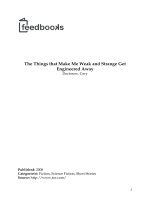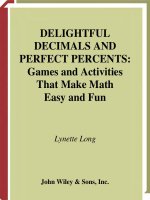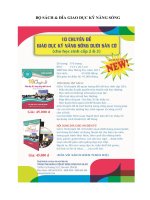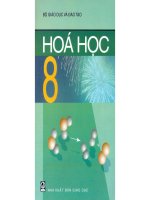Bộ sách Creative activities that make math science fun for kids Cool structures
Bạn đang xem bản rút gọn của tài liệu. Xem và tải ngay bản đầy đủ của tài liệu tại đây (8.66 MB, 34 trang )
-TO LIBRAR
Y
HOW
CHECKERB
OA
RD
COOL ART WITH MATH & SCIENCE
STRUCTURES
CREATIVE ACTIVITIES THAT MAKE MATH & SCIENCE
FUN FOR KIDS!
ANDERS HANSON AND ELISSA MANN
C O O L A R T W IT H MAT H & SCIEN CE
STRUCTURES
CREAT IVE A C TIVITIE S T H A T M A K E M A T H
FUN FOR KIDS!
ANDERS HANSON
&
SC I E N C E
AND ELISSA MANN
V I S IT U S AT W W W. A B D O P U B LI S H I N G.CO M
Published by ABDO Publishing Company, a division of ABDO, P.O. Box 398166, Minneapolis,
Minnesota 55439. Copyright © 2014 by Abdo Consulting Group, Inc. International copyrights
reserved in all countries. No part of this book may be reproduced in any form without written
permission from the publisher. Checkerboard Library™ is a trademark and logo of ABDO Publishing
Company.
Printed in the United States of America, North Mankato, Minnesota
062013
092013
Design and Production: Anders Hanson, Mighty Media, Inc.
Series Editor: Liz Salzmann
Photo Credits: Anders Hanson, Shutterstock
LIBRARY OF CONGRESS CATALOGING-IN-PUBLICATION DATA
Hanson, Anders, 1980Cool structures : creative activities that make math & science fun for kids! / Anders Hanson and Elissa
Mann.
pages cm. -- (Cool art with math & science)
Includes index.
ISBN 978-1-61783-825-5
1. Building--Juvenile literature. 2. Architecture--Juvenile literature. 3. Geometry--Juvenile literature.
4. Mathematical recreations--Juvenile literature. 5. Scientific recreations--Juvenile literature.
6. Creative activities and seat work--Juvenile literature. I. Mann, Elissa, 1990- II. Title.
TH149.H36 2013
507.8--dc23
2013001900
C O NT E NT S
4
6
8
12
14
18
COOL STRUCTURES
BITS A N D P I EC ES P UT TOG ET HE R
P YR A M I D S
A N CIEN T G EOM ET RY
P ROJE C T
1
BUILD A PYR A M I D
B RI D G E S
GET OV ER I T !
P ROJE C T
2
BUILD A BR I D G E
S LI N G I T
STRUC T UR ES I N AC T I ON !
20
24
26
30
31
31
32
PROJEC T
3
B U I L D A C ATA P U LT
TOW ERS
B U I L DI N G H I G H
PROJEC T
4
S PAG H E TTI TOW E R C H A L L E N G E
M A TH TERM S
GLOS S A RY
W EB S ITES
INDEX
STRUCTURES
BITS AND PIECES
PUT TOGETHER
S
tructures are useful arrangements of materials. They have many different
parts and pieces. The pieces come together to give the structure form and
function. Structures provide shelter, transportation, and culture. Some of the
most popular destinations in the world are structures. The Statue of Liberty,
the Eiffel Tower, the Golden Gate Bridge, and the Egyptian pyramids are a few
examples of world famous structures.
4
Skyscrapers tower over many cities. Burj
Khalifa in Dubai is the tallest structure in
the world. It is 2,717 feet (828 m) tall!
Bridges help people cross gaps. The
Golden Gate Bridge is one of the most
famous bridges in the world!
5
PY RAMID S
ANCIENT GEOMETRY
T
housands of years ago, the Egyptians built pyramids out of stone. They were the first
great structures. The largest Egyptian pyramid is the Great Pyramid of Giza. It is the
oldest of the Seven Wonders of the Ancient World. It is the only one still standing today.
It was the tallest building in the world for more than 3,800 years!
6
The Egyptian pyramids aren’t just amazing buildings. They are also geometric forms.
A pyramid is a 3-D shape with triangular sides. The sides meet at a point called the
apex. The base of a pyramid can be any type of polygon. The ancient pyramids in
Egypt have square bases. They are called square pyramids.
TYPES OF PYRAMIDS
APEX
BASE
TETRAHEDRON
(3-SIDED BASE)
SQUARE PYRAMID
(4-SIDED BASE)
7
PENTAGONAL PYRAMID
(5-SIDED BASE)
8
PROJ E C T
1
BUILD A
PYRAMID
STUFF
Y O U´L L
NEED
đƫ 30/60/90
TRIANGLE
đƫ A LARGE PIECE
OF CARDBOARD
đƫ PENCIL
đƫ SCISSORS
đƫ DUCT TAPE
đƫ FOAM BRUSH
đƫ MOD PODGE
đƫ SAND
TERMS
đƫ ANGLE
đƫ DEGREE
đƫ PYRAMID
F
ollow in the footsteps of the ancient Egyptians.
Make your own square pyramid! But don’t stop
there. Make a tetrahedron too, using four triangles.
Or try a pentagonal pyramid using one more triangle.
Before you know it, you’ll have a city of pyramids!
Tip: A 30/60/90 triangle is a type of triangle template.
You can find them at most art supply stores.
9
đƫ SQUARE
đƫ PENTAGONAL
đƫ TETRAHEDRON
đƫ TRIANGLE
1
HOW TO MAKE IT
2
1
Use a 30/60/90 triangle to draw a
60-degree angle on the cardboard.
Make the lines as long as you
want. The longer the lines, the
bigger your pyramid will be.
2
Flip the 30/60/90 triangle over.
Line the bottom of the triangle
up with the bottom line you just
drew. Draw a line that connects
the two lines you drew in step 1.
3
Carefully cut out the triangle.
Trace around the triangle
on the cardboard.
3
10
4
4 Trace two more triangles on the
cardboard. Cut out the triangles.
5
Lay the four cardboard triangles next
to each other with their sides lined up.
Tape the triangles together. Put tape
on the side of one of the end triangles.
6
Fold the taped triangles up so the
tape is on the inside. Line up the sides
of the end triangles. Use the tape to
hold them together. The triangles are
the sides of your square pyramid.
5
7 Use a foam brush to spread Mod
Podge on one of the sides. Sprinkle
a lot of sand over the Mod Podge.
8 Repeat step seven for the
other three sides. Let the Mod
Podge dry completely.
6
11
BRID G E S
GET OVER IT!
S
ince the dawn of history people have built bridges. Bridges span
obstacles. They help people cross from one place to another. The first
bridges were simple. They were made of rope, stone, or logs. Today’s
bridges are more complex. They use many different materials and designs.
THE MIGHTY
TRIANGLE
The triangle is the
strongest polygon. It
is very hard to bend or
break. Because of their
strength, triangles are
often used in bridges.
12
BEAM BRIDGE
A beam bridge is the simplest bridge. It
lies in a straight line, going from one side
to another.
ARCH BRIDGE
An arch bridge rises in the middle. The
arch is held up on each end by supports
called abutments.
SUSPENSION BRIDGE
Strong cables support suspension
bridges. The cables are attached to big
towers. The cables are held down at
each end of the bridge by heavy blocks.
13
14
P ROJE C T
2
BUILD A
BRIDGE
STUFF
Y O U´L L
NEED
đƫ QUICK GRIP
GLUE OR
ANOTHER
ALL-PURPOSE
PERMANENT
ADHESIVE
đƫ NEWSPAPER
đƫ 43 ½-INCHWIDE WOODEN
CRAFT STICKS
đƫ BINDER CLIPS
TERMS
đƫ DIAGONALLY
đƫ TRIANGLE
đƫ PARALLEL
A
good bridge can support a lot of weight. Bridge
builders often use triangles to construct strong
bridges. Try building your own triangle bridge. Using a
lot of triangles will help make your bridge strong!
15
1
HOW TO MAKE IT
1
Glue four craft sticks together,
end-to-end. Let the glue dry.
Glue three craft sticks together,
end-to-end. Let the glue dry.
2
Use two craft sticks to connect
the rods you made in step 1. Glue
each end of a craft stick to one
end of each rod. Glue each end of
the second craft stick to the other
ends of the rods. Let the glue dry.
2
3 Arrange six craft sticks across the
frame you made in step 2. The
craft sticks should form equalsized triangles inside the frame.
4 Glue the six craft sticks to the frame.
Use binder clips to hold
the sticks in place.
4
16
5
5
Repeat steps 1 to 4 to make a
second frame. Let the glue on
both frames dry. Remove the
binder clips from the frames.
6
Have a friend hold the frames
parallel to each other. The longer
rods should be on the bottom. Glue
craft sticks diagonally across the
shorter rods. Glue some of them
above and some below the top rods.
6
7 Turn the bridge over and glue craft
sticks diagonally across the longer
rods. Use the same process as step 6.
8
Turn the bridge back over. Glue
more craft sticks across the bottom
rods. Arrange them so they cover
the space between the frames.
8
9 Test the weight your bridge
can hold! Balance the bridge
between two chairs. Add weight
to the middle of the bridge.
See how much it will hold.
17
SLING IT !
STRUCTURES IN ACTION!
C
atapults and slingshots are simple
but effective machines. To build
one, you need something stretchy,
such as a rubber band. You can stretch
or twist a rubber band but it returns to
its original shape when you let go.
POTENTIAL ENERGY
Some materials have potential energy. Potential
energy is stored energy. It’s ready to spring into
action at any time. Stretching a rubber band charges
it with potential energy. When the rubber band is
released, it moves! That’s called kinetic energy.
POTENTIAL
ENERGY
Pulling on the bands
stretches them. They
become charged
with potential
energy.
18
KINETIC ENERGY
CONSERVATION OF ENERGY
Kinetic energy is action! All moving
objects have kinetic energy. It
keeps objects in motion. Shooting
an object from a slingshot flings it
through the air. The more kinetic
energy it has, the farther it will go!
Energy cannot be created or destroyed. It can only
be changed into a different type of energy. The
potential energy in a stretched rubber band equals
the kinetic energy of the object it shoots. In other
words, the more you pull back, the farther it will fly!
KINETIC
ENERGY
Releasing the bands turns
the potential energy into
kinetic energy. The bands
snap forward and the ball
goes flying!
19
20
PROJ E C T
3
BUILD A
CATAPULT
STUFF
Y O U´L L
NEED
đƫ 22 ½-INCH-WIDE
WOODEN CRAFT
STICKS
đƫ 16 REGULAR
RUBBER BANDS
đƫ QUICK GRIP GLUE
OR ANOTHER
ALL-PURPOSE
PERMANENT
ADHESIVE
đƫ PLASTIC SPOON
đƫ A SMALL, SOFT
OBJECT
đƫ BINDER CLIPS
(OPTIONAL)
TERMS
đƫ PARALLEL
đƫ TRIANGLE
C
atapults are ancient structures used to launch
heavy objects. They were popular in the Middle
Ages. When the cannon was invented, the catapult
fell out of use. Make a catapult of your own with craft
sticks and rubber bands.
Tip: Use binder clips to hold the craft sticks together
while the glue is drying.
21
đƫ SQUARE
1
HOW TO MAKE IT
2
1
Lay six craft sticks on top of
each other. Wind a rubber band
tightly around each end of the
stack. Make a second stack of six
craft sticks the same way. Lay the
stacks parallel to each other.
2
Glue a craft stick across the
stacks at each end to make a
square base. Let the glue dry.
3 Stack two craft sticks. Wind a
rubber band tightly around each
end. Make three more stacks of
two craft sticks the same way.
4
4 Hold two of the stacks upright.
Overlap the tops to form a triangular
shape. Glue the tops to each other.
Glue the bottoms to one side of the
base. Glue the other two stacks to the
other side of the base the same way.
22
5
5
Attach the handle of the spoon to the
middle of a craft stick. Use a rubber
band to tie them together tightly.
6
Pull up a loop from one of the rubber
bands on the base. Twist the loop.
Put one end of the stick with the
spoon through the loop. Repeat on
the other side. You should be able
to move the spoon up and down.
7
6
Wrap a rubber band around
the tops of the triangles.
8 Raise the spoon and put it inside
the rubber band that goes across
the top of the catapult.
9 Pull the spoon down and load it
with a small, soft object. Release the
spoon and watch the object fly!
7
23









